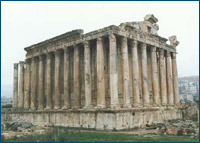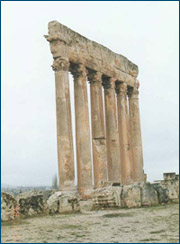| Random image |
 |

Fashion Festival at La Suite Oceana
|
 |
|
 |
 |
BAALBECK
 Baalbeck, 86km (53mi) north-east of Beirut, is one of Lebanon's oldest cities,
and one of the most important Roman sites in the Middle East. Baalbeck, 86km (53mi) north-east of Beirut, is one of Lebanon's oldest cities,
and one of the most important Roman sites in the Middle East.
It has the most
impressive classical ruins and was originally named after the Phoenician god
Baal. The town was renamed 'Heliopolis' (City of the Sun) by the Greeks. The
architectural remains are entirely of Roman design built in the 1st century AD.
Some historians attribute the enormous scale and rich detail of the buildings to
religious rivalry: Christianity was growing in popularity and the Romans wanted
to entice the local population to stick with pagan worship.
Baalbeck's temple complex is one of the largest in the world. The complex is
about 300m (984ft) long and has two temples with porticoes, two courtyards and
an enclosure built during the Arab period.
The Temple of Jupiter, completed around 60 AD, is on a high platform at the top
of a monumental staircase; only six of its colossal columns (22m/72ft) remain,
giving an idea of the vast scale of the original building. Constructed during
the first century AD, nothing in the whole of Roman antiquity was as large as
the Temple of Jupiter. Only six of its 54 Corinthian columns remain. Each column
is 66 feet high and seven and a half feet thick giving an idea of the colossal
size of the original building
Outside the main area is a tiny, exquisite Temple of Venus, a gorgeous circular
building with fluted columns. You'll enter the complex through the Propylaea a
colonnaded entrance and then proceed through a hexagonal court to the Great
Court with its two altars where sacrifices took place. Straight ahead up the
wide set of stairs is what remains of the Temple of Jupiter. Only six of the
original 54 columns are still standing but these alone give you an idea of the
incredible height of the building. The columns are said to be the largest in the
world.
 Though smaller than the Temple of Jupiter the nearby Temple of Bacchus is a
wonderfully preserved architectural beauty. Take your time walking around its
outer portico marveling at the intricately carved stone. From this position you
also have a good view of the huge stone blocks that formed the foundation for
the Temple of Jupiter-some of the blocks are believed to weigh more than 1,000
tons. Finally enter the Temple of Bacchus at its eastern end walking up the
flight of stairs and through the ornate doorway. Peer up at the keystone which
was a popular subject for sketch-happy 18th-century European travelers. Their
drawings show the stone hanging perilously low but it seems to have been reset
in recent times with modern mortar.
Though smaller than the Temple of Jupiter the nearby Temple of Bacchus is a
wonderfully preserved architectural beauty. Take your time walking around its
outer portico marveling at the intricately carved stone. From this position you
also have a good view of the huge stone blocks that formed the foundation for
the Temple of Jupiter-some of the blocks are believed to weigh more than 1,000
tons. Finally enter the Temple of Bacchus at its eastern end walking up the
flight of stairs and through the ornate doorway. Peer up at the keystone which
was a popular subject for sketch-happy 18th-century European travelers. Their
drawings show the stone hanging perilously low but it seems to have been reset
in recent times with modern mortar.
Outside the acropolis stands the circular temple of Venus, and the remains of a
fourth temple dedicated to Mercury is close by. The temple complex was three
centuries in building and never finished. These fabulous Hellenistic-Roman
period ruins were the venue for the drama, music and dance performances at the
Baalbeck Festival from 1956 to 1974.
Baalbeck holds every summer a wonderful International Music Festival.
Baalbeck can be seen as a day trip from Beirut. Allow at least a half day (not
including travel time) for this impressive site.
|